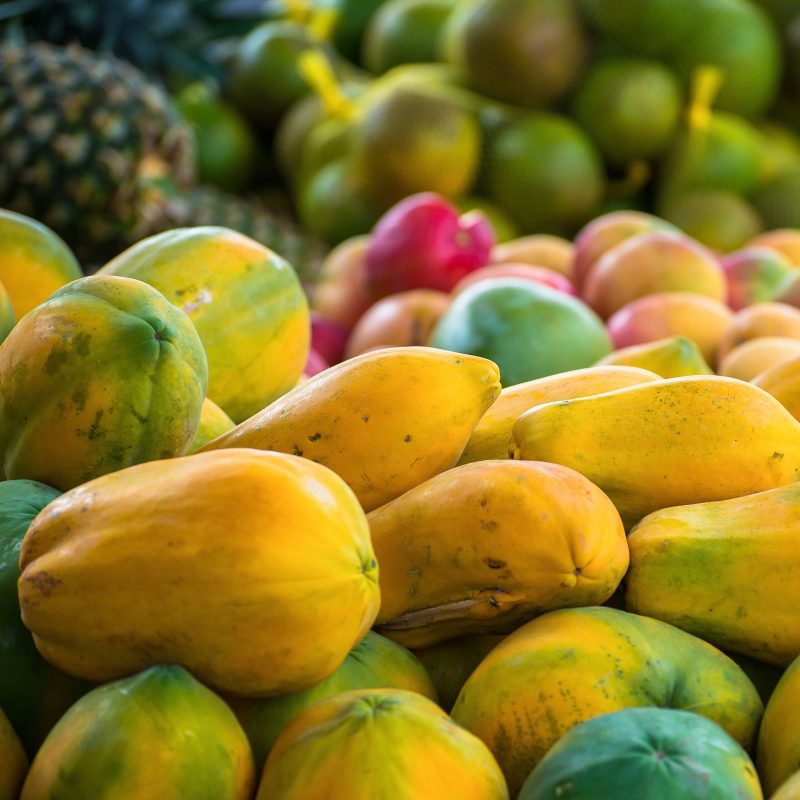
Costa Rica is known for its lush jungles, 500,000 different species of animals, and some of the most delectable and nutritious fruit in the world. Wander the farmers markets of this tiny Central American paradise, and you’ll find a rainbow of luscious fruit.
Videos by TravelAwaits
Fully embrace the local philosophy of pura vida, or pure life, by sampling these 10 Costa Rican delicacies.

1. Pitahayas
The pitahaya is the Central American version of dragon fruit. But while the creamy white or purple flesh of dragon fruit is cloaked in bright pink skin, the pitahaya has a vibrant yellow or red exterior. Both types of fruit, as well as tunas, are part of the cactus family.
You can find pitahayas at virtually any farmers market or supermarket in Costa Rica. Simply look for the signature red or yellow rind. You can tell whether or not the fruit is ripe by checking out the exterior. The pitahaya should be firm to the touch, brightly colored, and free of visible spots or soft areas.
The easiest way to eat pitahaya is to slice it in half and scoop out the soft white interior with a spoon. You can also slice it up and add it to a fruit salad or toss it into a smoothie. The taste is light and slightly reminiscent of the taste of a sweet kiwi.
2. Breadfruit
Breadfruit gets its name from its starchy composition and unique flavor. It’s filling, hearty, and decidedly more savory than sweet. Breadfruit is best roasted or fried and makes a great alternative to potatoes. It stands up to strong sauces and is a creative and appetizing choice in heavy soups or stir-fries.
You’re most likely to encounter breadfruit on Costa Rica’s Caribbean coast. When searching for the perfect piece, look for yellow-colored breadfruit with some brown spots. These spots usually indicate that an item is past its prime, but that’s not so with breadfruit.
The amazing taste is not the only reason you should scoop up some breadfruit on your next trip to Costa Rica. Breadfruit is absolutely bursting with nutrients and antioxidants!

3. Mangoes
Fresh Costa Rican mangoes will put the commercially harvested supermarket varieties you’re used to to shame. These dazzling orange morsels are available at virtually every market, and you should eat as many as humanly possible.
Although mango season is technically between March and June, you can find this fabulous fruit all year long. Ripe mangoes are relatively firm but not completely rigid. If one is squishy, it’s overripe. To eat, slice the mango in half and scoop out the delicious flesh with a spoon.
Like many tropical fruits, mangoes are rich in vitamins and antioxidants.
4. Granadillas
The granadilla is a type of passion fruit, and it contains many of the same nutrients. The difference mostly comes down to taste: While passion fruit is sour, granadillas are sweet. The hard-shelled portable fruit is a favorite in Costa Rica, and when you try it, you’ll understand why.
The granadilla has a tough exterior that’s generally deep orange in color. The edible parts are the gelatinous interior and crunchy seeds. Test for ripeness by gently shaking your granadilla. You should hear the sac moving around, but not too much. If your granadilla rattles, it’s not ripe yet.
Granadillas are fabulous for traveling. Their sturdy outsides make them great candidates for hiking trips or long bus journeys. To eat one, simply pry open the shell and gently open the interior sac.

5. Papayas
Papayas grow to astounding sizes in Costa Rica, and these jewel-toned tropical fruits are available year-round. Not only will you find massive papayas in the farmers markets and supermarkets, but you’ll also be treated to countless variations on the fruit.
Papayas are extraordinarily healthy, so incorporating copious amounts of this fruit into your diet will make your body happy. Fortunately, in Costa Rica, you’ll be able to enjoy fresh cubes of papaya, papaya smoothies, and papaya salsas.
Ripe papayas are greenish-yellow and soft to the touch. To enjoy, slice your papaya lengthwise and scoop out the seeds. The flesh should be velvety enough to remove with a spoon. Drizzle with fresh lime juice and sprinkle with salt for a refreshing treat.
6. Guanabanas
Guanabana is one of the most popular smoothie flavors in Costa Rica. This delicate white-fleshed fruit has the flavor profile of a pear with just a touch of pineapple or strawberry. It’s refreshing, subtle, and highly nutritious.
Guanabanas are quite large, so you’re most likely to see them in smoothie form, but the fruit is also served sliced or whole in some larger farmers markets. The flesh is soft and studded with large black inedible seeds. When the exterior is yellowish-green, your guanabana is perfectly ripe and ready to be eaten.
You’ll occasionally spot guanabana ice cream — it’s a fabulous local treat that you should certainly sample.

7. Rambutans
The rambutan is a Southeast Asian import that has caught on like mad in Costa Rica. Don’t let the strange exterior put you off — beneath the soft spikes is a translucent fruit that strikes the perfect balance between sweet and sour. Rambutans can be scooped up virtually anywhere during the rainy season, which runs from May through November.
Rambutans are particularly high in vitamin C. They’re freshest when their exteriors are deep red with bright green spikes.
8. Guabas
Easily one of the most interesting types of fruit in the world, the guaba is a white fuzzy fruit that tastes remarkably like vanilla ice cream, earning it the nickname “the ice cream bean.” This candied fruit is also very good for you and comes in a long seed pod that you slice open to eat.
You can find guabas at plenty of markets in Costa Rica. They grow quickly and are fairly hearty, so there’s an abundance of this sweet treat all over the country.
Once you crack or slice open the pod, you’ll find sections of airy white fruit covering black seeds. The seeds are not edible, but the fruit can be sucked off of each individual seed. Eating guabas properly requires a little bit of effort, but the decadent vanilla taste is definitely worth it.

9. Noni
To say that noni is an acquired taste is an understatement, but this savory and distinct fruit is one you should try in Costa Rica, if only once. Noni is predominantly served in juice form, the health benefits of which range from heart health to arthritis relief.
Noni has long been used as a medicinal fruit by coastal communities. Its smell and taste border on aggressive, with strong cheesy, funky notes. Still, the fruit is revered for its health benefits, so you should sip a fresh glass of noni juice if you have the chance.
10. Mangosteens
Not to be confused with the mango, the mangosteen is a phenomenal white-fleshed fruit that is widely praised for being an antioxidant powerhouse as well as a scrumptious treat. Mangosteens are usually available in the late fall or early winter, and you’ll recognize them by their deep purple rinds.
Mangosteens are roughly the size of small oranges and are very firm to the touch. They are ripe when their tough shells turn a dark purplish-red. Eating a mangosteen requires a bit of patience since the exterior is hard to break open. Once you do manage to get it open, prepare to get a purple stain on your fingers as you pry the opaque white fruit out of the rind. Mangosteen segments are small, and each one envelops a seed, so you’ll get less fruit than you want, but the fruit that you do get will be out of this world.
There are plenty of reasons to visit Costa Rica, and the sheer abundance of fruit is undoubtedly one of them. Make sure that you check out these farmers-market finds on your next trip to the Central American jewel.
Planning a trip to Costa Rica? Here are 15 things you shouldn’t miss while you’re there.

